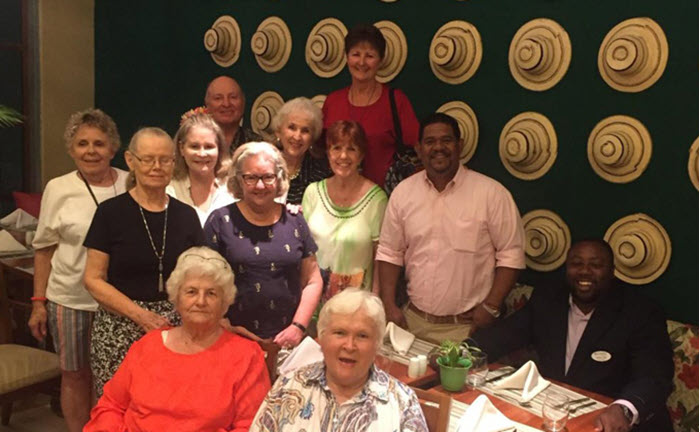Members of the Let’s Travel Club left on February 27 to enjoy nine exciting days on a Collette Discover Panama tour. Many activities were enjoyed as the travelers were introduced to several facets of the Panamanian folklore, culture, and traditions.
The introduction began with a visit to the Embera’ indigenous village. Musicians of the village welcomed the travelers as they arrived in dugout canoes. The morning was spent learning of the history of the Embera’ people, being entertained by the dancers and musicians, and even being fed a typical lunch consisting of fish, plantain, and fresh fruits. Tables were set up with items made by the villagers. Many of the travelers left with baskets, jewelry, and carvings all made by the men and women of the village.
The Panama Canal was a special highlight of the tour. In addition to actually riding on the Pacific Queen through two locks, the travelers had time in the Miraflores Visitor Center to walk through the multi-level museum and watch the workings of the locks system from the observation decks. The tour manager shared much of the history as to the need for the canal, the countries involved in the building of the canal, and the engineers responsible for the plans and organization of the work.
The travelers were introduced to the colonial area of Panama City as they walked through Casco Viejo (the Old Quarter). The group learned of the improvements in this area that have taken place over the recent years. A visit was made to the Mercado de Mariscos, a seafood market, where the group tried fresh Panamanian ceviche.
Time was spent during the tour learning of the research, protection, and preservation of butterflies, wild orchids, the golden frog and other amphibians, as well as the sloth.
Waterfalls are always beautiful to see. The group had time to visit the El Chorro Macho waterfall. There were suspension bridges to cross and a pool of refreshing water to enjoy. While a few travelers took advantage of the water with a swim, others spent a few minutes relaxing and enjoying the beauty of the area.
Artisans visited the travelers and shared the specifics of their talents as they made masks, drums, and the well-known La Pollera dress. The history of the mask centers around the introduction of Christianity to the natives in the 1600s. As a way to introduce the devil as evil, masks were made and used to scare the natives in an effort to scare them away from evil behavior. An explanation and demonstration of the drum introduced not only the materials used but also the different sounds that can be made with one drum.
The official dress of Panama (the La Pollera) is beautiful and can be made with a variety of stitching techniques. For example, the stitching can be cross-stitch, embroidery, crewel, applique, or embroidery with spaces between the designs. There could be as many as 25-30 women stitching for one year to make one dress. Once a person sees these dresses in person, it is easier to understand why the cost thousands of dollars. The dresses are worn for special ceremonies and are often passed down from generation to generation.
The making of the Panama hat was also demonstrated to the group. Preparing the palm leaves involves several steps from selecting, soaking, cutting, and finally weaving. The speaker also demonstrated the different ways to wear the hat to communicate. A person can say, “Leave me alone; I am busy,” or “Look at me; I am wealthy,” or “I would like to visit with you” all in the way the hat and brim are worn.
Mrs. Margarita welcomed the travelers to her farm where she has dairy cows, sheep, chickens, gardens of yucca and plantain to name a few. A tour of the farm was shared; then the work began. Some visitors worked preparing chicken for the lunch while others worked to make empanadas. Still others learned to make cheese from the mornings fresh milk. When the work was completed, everyone enjoyed a delicious, fresh lunch on the farm.
A stop was made when traveling from the farm to the hotel. Everyone visited and watched as a gentleman and his family demonstrated making pots, banks, and dishware from his potter’s wheel. Once his brother prepared the clay, the potter then used his wheel to create two pots of different shapes and an apple-shaped bank. Once the pieces are completed, they are fired and painted. The son of the potter paints the different pieces. The travelers met his wife as they admired and purchased some of the finished products.
As the tour was winding down to the last few days, the adventures continued. While enjoying another delicious authentic Panamanian dinner, the group was entertained by dancers performing traditional Panamanian dances. The first dancers were a couple with the man trying to persuade a particular young lady to like him rather than other suitors. The couple, of course, wore the traditional dress of Panamanian women and men during the performance.
A second entertainer wore a mask of a devil figure like the ones that were demonstrated earlier by the mask artist. He performed dances with music and castanet-like instruments. The dancers and the food were enjoyed by all.
The head bakery chef of the Cubita Resort Hotel (where the group was staying) demonstrated the making of an artisanal bread which is cooked in a clay oven and has become famous over the years. As the travelers enjoyed eating the bread, a few of the travelers assisted in pressing sugar cane so everyone could also enjoy fresh sugar cane juice known as guarapa.
The participants of the tour left Panama with a better understanding of the people and their culture and traditions thanks to Teo, the tour manager, and his guidance through his beloved country.
Let’s Travel Club Visits Panama
News from Panama / Tuesday, March 24th, 2020
